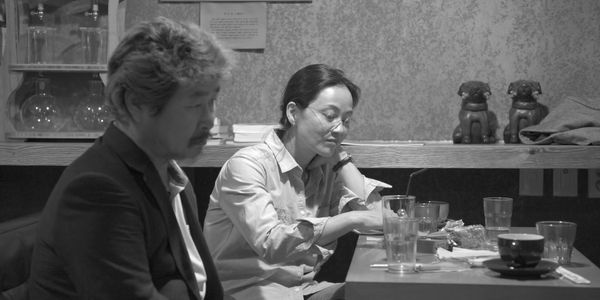GRASS: A Dance Of People & Words

Soham Gadre is a writer/filmmaker in the Washington D.C. area.…
“I’m a writer,” I say to myself. Yet, I struggle often to come up with the proper combination of words to explain my feelings. Truth be told, words are limiting and why writing about cinema, a medium that expresses itself foremost through the relationship of images is not as easy a task as people claim. Hong Sang-soo’s Grass is a movie defined through its visual cues and their intimate dance with the words that try to define them. It is a movie that tries its best to make clear the limits of vocabulary, by juxtaposing its words with the facial expressions of its actors, their limbs, and their eyes.
Words on Life and Death
Public conversations are a long-held fascination with human observation. We all have some weird tendency to want to listen in, build stories around them, makeup ideas about who these people are and what they’re doing and where they’re going in life. Maybe they’re saying something that we’ve wanted to say for a long time but couldn’t find the words for. Not all conversations are deep, some of them are about trivial everyday things. But in Grass, every conversation is an intricate miniature story. A young writer named A-reum (Kim Min-hee) observes people in different stages of life overcoming grief, death, reconciliations, and regret from her little corner of the café.

At the start of the film, two young people enter a confrontational discussion about the death of their friend. One blames the other. A-reum recites through narration the existential thoughts that must be going through their minds. How they can live with the blame for their friend’s death. Initially, it’s not certain whether this conversation is actually happening, or is a projection of A-reum’s own writing on her laptop.
A-reum’s mind rather than her gaze –signaled by the deliberate zooming into particular characters during moments of silence to signify contemplation of their thoughts– guides Hong’s decisions behind the camera. Once the first conversation ends, she turns (as does the camera) to a much older pair, both eerily similar in mannerisms to the younger counterparts in the first conversation. Are they another projection in A-reum’s mind of the same couple, just at a later stage in life? These lines are left blurred near the beginning to give us the sensation of A-reum as not just a writer but also an intricate storyteller.
Gender and Guilt
Almost every conversation in the movie is between a man and woman and thus by virtue, it investigates how their genders play a role in their interactions. When an actor comes to introduce himself and asks intrusive questions to A-reum, she is cryptic about her life as a writer, her process, and her philosophy. The man is quite an open book, pontificating and being upfront to the point of discomfort. A-reum’s curt responses could either be her nature as defensive and introverted or perhaps she is simply trying to get the man to leave her alone.

Gender roles are even switched in conversations. The opening conversation with a young woman accusing her male friend of their mutual friend’s death is reversed in roles later in the movie. The way the men and women both deal with this guilt in these two conversations is telling. The accused man goes for a walk outside. The accused woman breaks down crying.
Hong’s female characters are much more personal and externalize pain much more than the men in the film. Even A-reum, who starts the film off as a quiet and enigmatic observer unabashedly showcases her displeasure at her brother for getting engaged so soon to his girlfriend. Her remarks are piercingly personal to the point where her brother says she is “embarrassing”. On the contrary, an elderly suicidal man discusses his own suicidal thoughts with a sigh and hopeless lack of energy. His female companion is clearly uncomfortable about this and throughout the conversation, you can tell she is desperately finding ways to react compassionately while keeping a distance.
Living Under the Shadow of Death
We never really see a single word of what A-reum is typing. It’s just as well because we don’t need to. Her thoughts are either read aloud, juxtaposed with the various instances of silent pondering of the subjects she so acutely studies, but it’s clear their reactions say much more than her words can. Many of the things she questions are in regard to how humans process the idea of death, the ultimate experience of human existence and one that can never be reflected on in hindsight. But Grass is ultimately optimistic.
She ultimately comes into conversation herself with a few of the subjects she had been observing. The barrier is broken, and the façade of these subjects merely being a reflection of her writing is gone. A-reum assumes a place in human society. A recognition of Hong’s part that despite the looming clouds of death and regret there is, and must be, camaraderie among the living. We are all part of the same world and the same cycle of nature. After death, the body decays and decomposes. It becomes one with the soil and then sprouts the grass.
Watch Grass
Does content like this matter to you?
Become a Member and support film journalism. Unlock access to all of Film Inquiry`s great articles. Join a community of like-minded readers who are passionate about cinema - get access to our private members Network, give back to independent filmmakers, and more.
Soham Gadre is a writer/filmmaker in the Washington D.C. area. He has written for Hyperallergic, MUBI Notebook, Popula, Vague Visages, and Bustle among others. He also works full-time for an environmental non-profit and is a screener for the Environmental Film Festival. Outside of film, he is a Chicago Bulls fan and frequenter of gastropubs.












